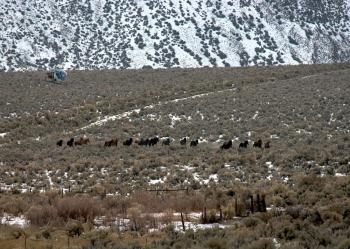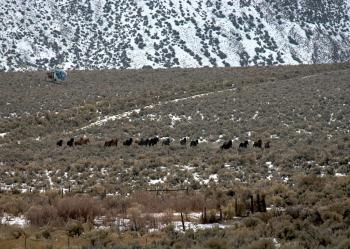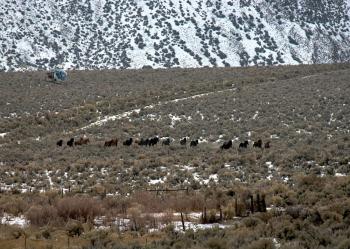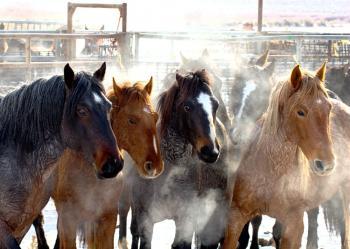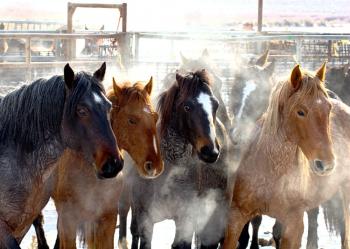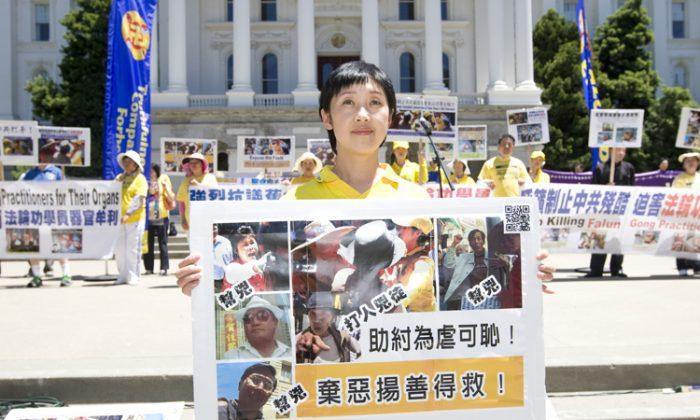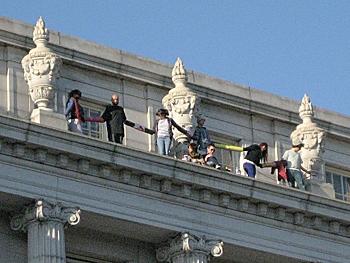Since the U.S. Bureau of Land Management (BLM) began a roundup of wild horses in the Calico Mountains Complex of Northern Nevada on Monday, Dec. 28, activists have cried out against the action, demanding a moratorium.
The BLM plans to remove 2,500 wild horses from the 500,000-acre Calico Mountains Complex, leaving about 600 to 900 wild horses and burros. In addition, they plan to impose fertility control on mares to remain in the area, with the goal of bringing the male/female sex ratio of horses to 60/40 percent. The roundup is to continue until late February or early March 2010, according to a press release.
The wild horse gather is projected to cost taxpayers $900,000, according to BLM Nevada State spokesperson JoLynn Worley. Since it’s very difficult to find adopters for the horses, remaining horses will be sent to the BLM’s permanent holding facilities, where the horses will be provided with food and veterinary care for the rest of their lives, said Worley. According to The Cloud Foundation, a wild horse preservation organization, there are already 34,000 wild horses warehoused by the BLM at taxpayers’ expense.
“The BLM is misrepresenting the facts, misrepresenting the statistics—blatantly misrepresenting the truth,” said Dr. Elliot Katz, DVM, president and founder of In Defense of Animals, a California-based international animal rights and welfare agency. He said that according to the 1971 Wild Horse Act, free-roaming horses and burros are “living symbols of the historic and pioneer spirit of the West; that they contribute to the diversity of life forms within the Nation and enrich the lives of the American people.” He said the BLM is acting counter the ideals put forth by Congress in gathering—really “battering,” Dr. Katz said—horses in order to make way for cattle ranching.
The Wild Horse Act was created to prohibit harm and disturbance of wild horses and burros and provide for their transfer to suitable areas when populations became too large, according to The American Mustang Foundation’s Web site.
The BLM plans to remove 2,500 wild horses from the 500,000-acre Calico Mountains Complex, leaving about 600 to 900 wild horses and burros. In addition, they plan to impose fertility control on mares to remain in the area, with the goal of bringing the male/female sex ratio of horses to 60/40 percent. The roundup is to continue until late February or early March 2010, according to a press release.
The wild horse gather is projected to cost taxpayers $900,000, according to BLM Nevada State spokesperson JoLynn Worley. Since it’s very difficult to find adopters for the horses, remaining horses will be sent to the BLM’s permanent holding facilities, where the horses will be provided with food and veterinary care for the rest of their lives, said Worley. According to The Cloud Foundation, a wild horse preservation organization, there are already 34,000 wild horses warehoused by the BLM at taxpayers’ expense.
“The BLM is misrepresenting the facts, misrepresenting the statistics—blatantly misrepresenting the truth,” said Dr. Elliot Katz, DVM, president and founder of In Defense of Animals, a California-based international animal rights and welfare agency. He said that according to the 1971 Wild Horse Act, free-roaming horses and burros are “living symbols of the historic and pioneer spirit of the West; that they contribute to the diversity of life forms within the Nation and enrich the lives of the American people.” He said the BLM is acting counter the ideals put forth by Congress in gathering—really “battering,” Dr. Katz said—horses in order to make way for cattle ranching.
The Wild Horse Act was created to prohibit harm and disturbance of wild horses and burros and provide for their transfer to suitable areas when populations became too large, according to The American Mustang Foundation’s Web site.
According to the BLM, the gathering of wild horses in the Calico Mountains Complex is necessary because of unsustainable appropriate management levels (AML) of wild horse populations. According to their Web site, the current population of 3,040 animals is about three times the land’s full carrying capacity, or high range AML of 952 horses.
However, the number of horses is far less than “excess,” said Dr. Katz. He said that while the Wild Horse Act stipulated removal or even euthanasia of horses when they become old or extremely starved, that is not the case for horses in the Calico Mountains Complex today. From footage and photographs of the area he has seen, he said that the number of horses in the area is far less than what the BLM has reported. In addition, he said the horses are perfectly healthy. Their roundup by helicopter may cause stampedes, induce injury in the cold weather, and even lead to burst lungs and pneumonia, Dr. Katz said. He added that the act was “very vicious.”
The BLM’s rationale for the wild horse roundup is that overpopulation of horses in the area will cause damage to rangeland resources, such as rangeland vegetation and springs, streams, and seeps. According to a BLM fact sheet, the overwhelming wild horse population would “negatively impact Lahontan cutthroat trout in streams with stream bank trampling, increased sedimentation, reduced vegetation cover, and overall reduced riparian and stream habitat condition.” Moreover, the BLM believes that this action will prevent the need for emergency roundup when water and vegetation become scarce in the area.
“[This is] total rhetoric and misinformation that the BLM is putting out there,” said Dr. Katz. He said that in its eagerness for increased cattle grazing, the BLM has fenced off waterholes so that the horses can’t get to them, while cattle can.
“Right now they have thousands of horses and millions of cattle in that land,” said Dr. Katz. He said he saw the animals in footage he sent a cameraman to get, flying over the area, a few weeks before the roundup. “[There are] ‘too many’ horses because they keep leasing out land to the ranchers. [The BLM] created an artificial situation that tends to be putting pressure on the horses.”
Asked for an estimate of the number of cattle on the Calico Mountains Complex, Worley responded that they keep no such figure, and said there are “hardly any out there.”
Visitors to the range claim that the land can indeed support the herds of horses, contrary to BLM statistics, said Tori Perry, Emergency Response Manager in the Cruelty Investigations Department at People for the Ethical Treatment of Animals (PETA) in an e-mail. She said that many horses are sold at auction, and those over ten years of age can be trucked to Canada and Mexico for slaughter. Her organization also wants the BLM to stop using helicopters to herd the animals. Helicopter roundups “are inherently cruel and simply can’t be carried out humanely,” she wrote.
Dr. Katz and fellow activists have filed a lawsuit against the action and while an U.S. District Court judge has recommended temporary injunction while matters can be more carefully examined, the BLM has no signs of ceasing the roundup.
“The roundup follows very much in the way Native Americans were treated—the broken treaties, broken promises, moving them into reservations, moving them into corrals,” said Dr. Katz.
“It’s a land grab for the cattle industry, it’s a land grab for mining and gas industries to get a hold of that land. Horses [are seen as] just pests, not seen as a symbol of American freedom.” He said that the roundup is in violation of the intent of Congress and the current 30,000 horses put in corrals would have never been allowed in the initial Wild Horses Act.
Lise Stampfli Torme, a wild horse advocate and Cloud Foundation volunteer stated, “We are outraged that BLM is proceeding with this roundup under a cloud of controversy and against a U.S. District Court judge’s recommendation. The agency has moved the capture points to private land where the public cannot see how their contractors are treating our living legends,” in a Cloud Foundation press release.
Activists call for an immediate moratorium on the wild horse roundup as protests erupted in San Francisco, Chicago, Longmont, Colorado, and Ketchum, Idaho, Thursday.
However, the number of horses is far less than “excess,” said Dr. Katz. He said that while the Wild Horse Act stipulated removal or even euthanasia of horses when they become old or extremely starved, that is not the case for horses in the Calico Mountains Complex today. From footage and photographs of the area he has seen, he said that the number of horses in the area is far less than what the BLM has reported. In addition, he said the horses are perfectly healthy. Their roundup by helicopter may cause stampedes, induce injury in the cold weather, and even lead to burst lungs and pneumonia, Dr. Katz said. He added that the act was “very vicious.”
The BLM’s rationale for the wild horse roundup is that overpopulation of horses in the area will cause damage to rangeland resources, such as rangeland vegetation and springs, streams, and seeps. According to a BLM fact sheet, the overwhelming wild horse population would “negatively impact Lahontan cutthroat trout in streams with stream bank trampling, increased sedimentation, reduced vegetation cover, and overall reduced riparian and stream habitat condition.” Moreover, the BLM believes that this action will prevent the need for emergency roundup when water and vegetation become scarce in the area.
“[This is] total rhetoric and misinformation that the BLM is putting out there,” said Dr. Katz. He said that in its eagerness for increased cattle grazing, the BLM has fenced off waterholes so that the horses can’t get to them, while cattle can.
“Right now they have thousands of horses and millions of cattle in that land,” said Dr. Katz. He said he saw the animals in footage he sent a cameraman to get, flying over the area, a few weeks before the roundup. “[There are] ‘too many’ horses because they keep leasing out land to the ranchers. [The BLM] created an artificial situation that tends to be putting pressure on the horses.”
Asked for an estimate of the number of cattle on the Calico Mountains Complex, Worley responded that they keep no such figure, and said there are “hardly any out there.”
Visitors to the range claim that the land can indeed support the herds of horses, contrary to BLM statistics, said Tori Perry, Emergency Response Manager in the Cruelty Investigations Department at People for the Ethical Treatment of Animals (PETA) in an e-mail. She said that many horses are sold at auction, and those over ten years of age can be trucked to Canada and Mexico for slaughter. Her organization also wants the BLM to stop using helicopters to herd the animals. Helicopter roundups “are inherently cruel and simply can’t be carried out humanely,” she wrote.
Dr. Katz and fellow activists have filed a lawsuit against the action and while an U.S. District Court judge has recommended temporary injunction while matters can be more carefully examined, the BLM has no signs of ceasing the roundup.
“The roundup follows very much in the way Native Americans were treated—the broken treaties, broken promises, moving them into reservations, moving them into corrals,” said Dr. Katz.
“It’s a land grab for the cattle industry, it’s a land grab for mining and gas industries to get a hold of that land. Horses [are seen as] just pests, not seen as a symbol of American freedom.” He said that the roundup is in violation of the intent of Congress and the current 30,000 horses put in corrals would have never been allowed in the initial Wild Horses Act.
Lise Stampfli Torme, a wild horse advocate and Cloud Foundation volunteer stated, “We are outraged that BLM is proceeding with this roundup under a cloud of controversy and against a U.S. District Court judge’s recommendation. The agency has moved the capture points to private land where the public cannot see how their contractors are treating our living legends,” in a Cloud Foundation press release.
Activists call for an immediate moratorium on the wild horse roundup as protests erupted in San Francisco, Chicago, Longmont, Colorado, and Ketchum, Idaho, Thursday.
